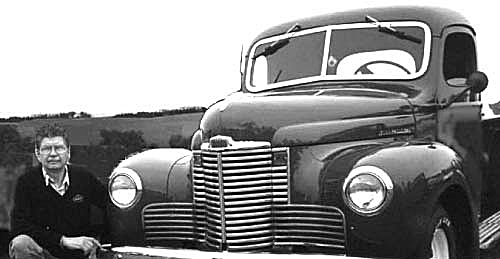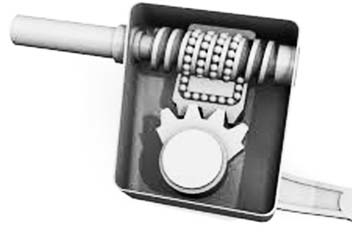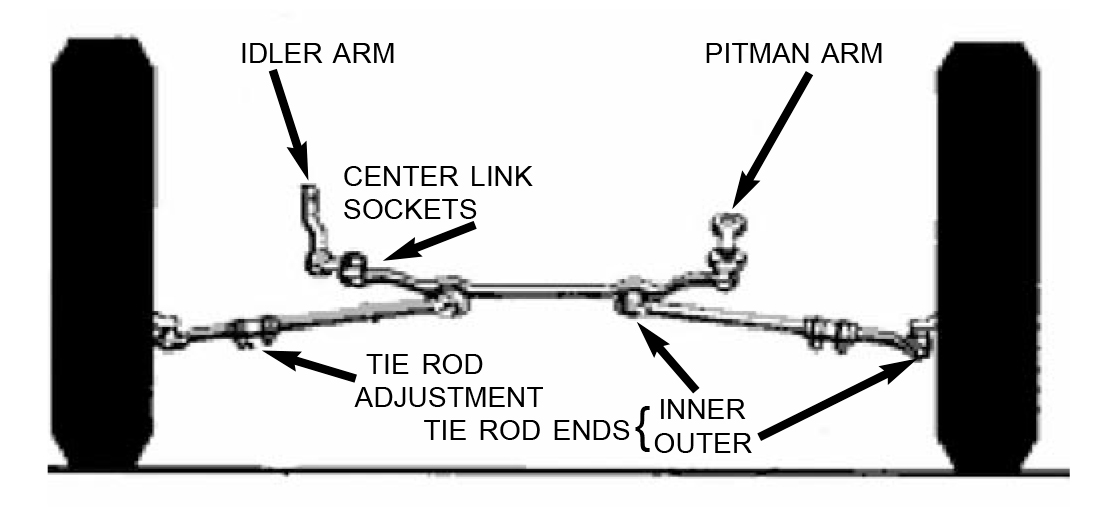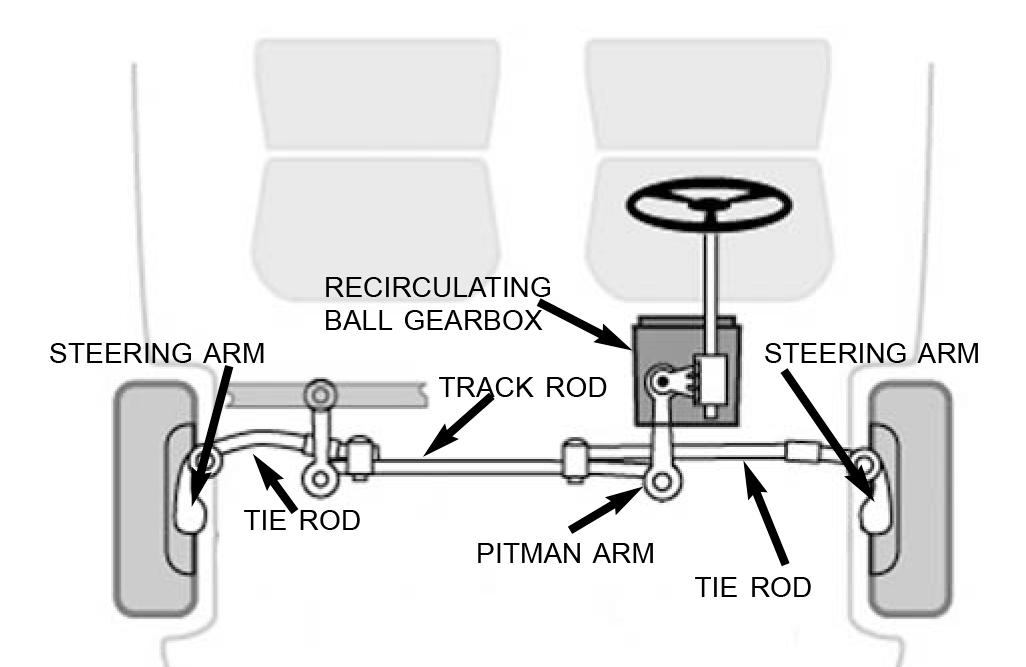Skunned Knuckles
Skunned Knuckles Articles
by Orest Lazarowich
The Recirculating Ball & Nut Steering Gear

General Motors pioneered this design and the first application was for the 1940 Cadillac model 72. By the mid-'50s every General Motors vehicle car and truck, whether manual or power steering equipped, came with the patented Saginaw recirculating ball and nut steering gear. This type of steering gear is very low in friction and provides adequate mechanical advantage for the vehicle. Most of these vehicles are still difficult to steer because they are large and heavy. A large diameter steering wheel was used for manual steering but when the power steering was optioned a 14-15 inch steering wheel was used to reduce input sensitivity. A smaller steering wheel diameter also provided more interior room and a comfortable driving position. During the '50s, '60s, '70s and through the early '80s many other vehicle manufacturers adopted the design and it is commonly called the recirculating ball nut type steering gear.
RECIRCULATING BALL NUT TYPE STEERING GEAR

In this type of steering gear, the end of the worm shaft is machined with a continuous helical groove. Precision finished helical grooves inside the ball nut match the helical grooves on the wormshaft which are filled with ball bearings. These ball bearings move the ball nut assembly up or down the wormshaft when the steering wheel is turned. There are two complete ball bearing circuits within the ball nut. To keep the ball bearings from running out of the end of either circuit, the ball nut has two tubular ball guides which allow the ball bearings to con-stantly re-circulate, distributing wear evenly among them. The ball bearings circulate in one direction for a right hand turn and in the other direction for a left hand turn. The outside of the ball nut has gear teeth cut into it which engage with the Pitman shaft to move the Pitman arm. The Pitman arm in turn transmits the desired directional movement to the front wheels through the steering linkage. In vehicles with the collapsible style steering column the worm shaft is SECTOR GEAR WORM GEAR shortened and protrudes out PITMAN SHAFT of the steering PITMAN ARM box as a stub shaft. This stub shaft is connected by a coupler (rag joint) to another shaft that the steering wheel is mounted on. The rag joint helps to eliminates road vibration and steering pump noise to the steering wheel.

STEERING LINKAGE
One type of steering linkage for a recircu-lating ball-type steering gear consists of a steering gear Pitman arm, a relay rod (center link), two adjustable tie rods and an idler arm. The Pitman arm is splined on the steering gear sector shaft. When the steering wheel turns the sector shaft the Pitman arm swings in an arc. The swinging end of the Pitman arm is connected to the relay rod through an adjustable ball and socket joint. The relay rod is connected to an idler arm fastened to the frame opposite the steering gear. The center link which is connected to the tie rods transfers the swinging motion to a back-and-forth motion of the steering arms. The steering arms are connected to the steering knuckles which control the front wheels.


STEERING GEAR MAINTENANCE
There has to be some free play in the steering wheel, and as general rule one to two inches of free play is okay when the steering column is unlocked. If you can move the steering wheel more than an inch or two when the vehicle is standing still and the front wheels do not move, there is too much free play in the steering wheel. This can be caused by wear in the steering linkage and/or the steering gear. Raise the front of the vehicle, and place the safety stands under the frame and behind the front tires. Chock both rear wheels, and leave the vehicle in gear or Park. Check that the steering gear housing bolts are tight to the frame. Move each of the front wheels by grasping the sides of the tire and moving it back and forth with a rocking motion. There should not be any excessive movement, but if there is, check the tie rod ends and the ball joints. To check for wheel bearing wear grasp each wheel at the top and bottom and try to rock it. There should be minimal movement. Excessive play may indicate the wheel bearing is worn or needs adjustment or replacement.
SHOCK ABSORBERS
The shock absorbers and the coil springs help to keep the wheels of the vehicle on the road-way when the vehicle is in motion. When the wheels start to bounce excessively the tires are not in complete contact with the roadway and the result is the feeling of too much play in the steering wheel. Visually inspect the front and rear shock absorbers for leakage. A small amount of weeping is normal but if the shock absorber is covered with oil the shock absorber is defective and must be replaced. Coil springs do lose their strength over time, and a drop in ride height is one of the first signs of this loss. Visually inspect the coils for signs of cracks and shiny surfaces between the coils which indicate the spring is weak and the coils are bottoming. Weak shock absorbers and coil springs can cause the front tires to develop a wear pattern called ‘feathering.’ This is a condition where the edge of each tread rib develops a slightly rounded edge on one side and a sharp edge on the other. To check for this problem keep firm pressure on your hand and slide it flat on the tire tread. In one direction the tire will feel smooth and in the other there will be a sharp edge to the tread. This tire wear can also be caused by alignment problems. Changing coils springs can be a dangerous procedure. Follow the service manual instructions and observe all safety precautions.
TIE ROD ENDS
Tie rod ends are used to connect the tie rods to the center link and the steering arms. A tie rod end is a ball located in a socket. The ball is attached to a tapered stud. A spring or plastic spacer holds the ball in position in the socket. The tapered stud fits into a taper in a steering arm and is held in position by threaded nut and cotter pin. The ball and socket allow for up and down movement between the tie rod and the steering arm and also allow back and forth movement when the steering wheel is turned. Grease is held between the ball and socket with a grease seal. Adjustment of the tie rod length is provided in threaded sleeves that are locked by clamps.
You may find it easier to replace worn outer tie rod ends by removing the front wheels and having more working room. Remove the cotter key from the tie rod nut, and then remove the nut. Use a pickle fork to remove the tie rod end from the steering knuckle. Loosen the clamp, and count the number of turns it takes to remove the tie rod end from the tie rod. Purchase the proper tie rod end. Screw the new tie rod end into the tie rod the required number of turns. Insert the tie rod into the steering knuckle and tighten the nut securely. Fit in the cotter pin. Do not loosen the nut to align the cotter key, tighten the nut a bit more. Tighten the tie rod clamp. Install the wheel(s).
BALL JOINTS
Ball joints connect the steering knuckles to the upper and lower control arms and the steering linkage turns the steering knuckles. On the Short-Long Arm (SLA) suspensions where the spring seats on the lower control arm the lower ball joint carries the load and is most likely to be worn and need replacing. The upper ball joint does not carry any weight. On SLA suspensions where the coil spring is over the upper control arm, the upper ball joints are loaded and the lower ones are unloaded. The ball joints in most vehicles are sealed and do not require lubrication. Ball joints on older passenger cars and light trucks do have grease fittings and require periodic lubrication. Some ball joints have wear indicators and one style has a raised shoulder at the base of the grease fitting that protrudes about 0.050 inch out from the base of the ball joint. As the ball joint wears, the raised shoulder moves into the ball joint. When the shoulder is flush with the joint the ball joint should be replaced. Another type uses the grease fitting as a wear indicator. When the grease gun will not couple to the grease fitting, the ball joint needs to be replaced.


If the ball joint does not have a wear indicator, the ball joint can be checked for wear by relieving the tension on the lower ball joint. Raise the wheel off the ground, and support the lower control arm near the ball joint. Check the lower ball joint for vertical movement by prying the tire up and down with a bar. To check for lateral movement rock the wheel in and out. Any looseness in the upper ball joint indicates ball joint replacement. Load carrying lower ball joints with wear indicators must be checked with the weight of the vehicle on the wheels. If the wear indicator is still protruding from the surface of the ball joint housing, the ball joint is considered good. If the ball joints are worn, check the control arm bushings for wear because they are important to the stability of the suspension system. Replace the control arm bushings as necessary.

Ball joints may last 100.000 miles or more, if they are properly maintained. If the ball joint is worn, it should be replaced. To save the expense of having to replace the unworn ball joint at a later time, replace both ball joints upper and lower at the same time. Some ball joints are pressed into the control arms and you need special tools to remove them. You can rent the tools or remove the control arm, and use a hydraulic press to disassemble and reassemble the ball joints. Some ball joints are attached to the control arm by rivets. These must be chiseled or drilled out to replace the ball joint. The new ball joint kit comes with nuts and bolts to secure the new ball joint to the control arm. Some ball joints are permanently attached to the control arm, and the control arm assembly must be replaced, if the ball joint is worn out.
Before you make any adjustments to the steering gear to correct loose or hard steering make the above checks and correct the problems. All steering linkage parts are manufactured from malleable materials and will bend, distort, or deflect rather than fracture under extreme shock loads. This toughness and malleability are necessary to avoid the complete loss of control that would occur if any part of a steering linkage were to break. Steering linkage parts must never be heated during a repair because this could cause them to lose their malleability and fracture when under stress.
STANDARD STEERING GEAR ADJUSTMENTS ON VEHICLE
Raise the hood, and cover the front left fender with a fender cover. Move your belt buckle to the side of your waist. Check for signs of lubricant leakage at the Pitman shaft. The early styles of this steering gear use two bushings to support the Pitman shaft and a seal at the Pitman arm end to contain lubricant leaks. There are only two adjustments on this steering gear. The worm shaft bearing load and the gear mesh load. Disconnect the steering relay rod from the Pitman arm by removing the cotter pin from end of relay rod, then removing the end plug, spring, spring plug and ball seat. Separate the relay rod from the Pitman arm. Get a good hold of the Pitman arm, and try to move it up and down/side to side. There will be very little movement, but if there is lubricant leakage past the bottom bushing and seal, the Pitman shaft and the bushings are starting to wear. Remove the lubricant pipe plug, and check lubricant level. It should be up to the bottom of the opening. Add SAE 80-90W multipurpose gear oil, if necessary. The worm shaft sets in two caged ball bearings and acts as the inner races of these bearings. On one style of steering gear the top bearing is mounted in the steering gear housing and is stationary. The bottom bearing is located in an adjustment nut and is therefore adjustable. Turning the adjustment nut in brings the two bearings closer together and clamps the worm section of the input shaft between them. The adjustment here must be enough to eliminate any endplay but must not bind the bearings and cause them to wear excessively.
Loosen the Pitman shaft lash adjuster screw lock nut, and turn the adjuster screw a few turns in a counterclockwise direction. This removes the load imposed on the worm bearings by the close meshing of rack and sector teeth. Turn the steering wheel gently in one direction until stopped by the gear, and then back away about one turn. Use a fishing scale to measure the pull at the rim of the steering wheel. Keep the scale at right angles to the wheel spoke to measure the pull. On some types of recirculating steering the reading on the scale should be between 3/8 and 5/8 pounds. Check manufacturer's recommended procedures and specifications for your vehicle. If the pull to move the wheel does not lie between the limits given limits, adjustment of the worm shaft bearings is necessary.
ADJUSTING WORM SHAFT BEARINGS
Loosen the worm bearing adjuster lock nut. Turn the worm bearing adjuster cap which is threaded into the housing clockwise until there is no end play at the steering wheel. Check the pull at the wheel rim, readjusting if necessary to obtain the proper pull. You want the least amount of resistance to steering wheel movement. Tighten the lock nut, and recheck the pull. Be sure the worm bearing adjuster cap does not turn while tightening the locknut. Turn the steering wheel slowly to either stop. If the steering wheel movement is "rough" after adjusting the worm shaft bearings, there is probably damage in the bearings. The steering gear must be removed for dis-assembly and inspection.
ADJUSTING PITMAN SHAFT LASH ADJUSTER SCREW
The teeth of the ball nut and the teeth of the sector shaft mesh together. The space between the two center teeth on the ball nut is machined slightly smaller than the other spaces and contacts the center tooth of the sector shaft more tightly. This design causes the mesh of the teeth to tight-en at the center of travel, which is where the steering gear is when driving straight down the road and helps to eliminate any tendency to wander. Too little mesh and the vehicle will wander when traveling in a straight line. Too much mesh and the teeth will bind, causing wear and in some cases breakage of gear teeth.
First, turn the steering wheel gently from one stop all the way to the other, counting the total number of turns. Now, turn the steering wheel back exactly half way, to center position. Turn the Pitman shaft lash adjuster screw clock-wise to take out all lash in the gear teeth and tight-en the lock nut. Turn the steering wheel off center position. Check the pull at the steering wheel rim as the steering wheel is turned through center position. This should be between 7/8 and 1 1/2 pound and then go back to between 3/8 and 5/8 pounds. Readjust to obtain proper pull. Follow the service manual procedures and connect the Pitman arm to the relay rod. Make sure the inner ball seat is in place in the relay rod. Place the seal and cover plate on the Pitman arm ball, and fit the Pitman arm in place in the relay rod. Install the outer ball seat, spring and end plug. Screw the end plugs in until the springs compress and the plug bottoms. Back off the end plug 3/4 turn plus the amount necessary to insert the cotter pin. Insert the cotter pin. Mount the wheels and tires if they were removed. Check tire air pressure. Road test the vehicle.
REMOVING THE STEERING BOX
If the front suspension does not have excessive free play but the steering wheel has, and if it binds when it is turned end to end, remove the steering box for inspection. A rebuild kit containing new bearings and bushings is avail-able, but if the wormshaft, ball nut or Pitman shaft are pitted or severely worn, it might be wiser to exchange the gear box for a rebuilt one. Power wash the steering box and Pitman arm area. Bring the vehicle into your work area. Refer to the service manual steering gear section to determine whether the mast jacket and steering gear can be removed from the top through the floor boards or from below the vehicle. If this vehicle has a two piece wormshaft connected by a coupler (rag joint), the mast jacket and steering wheel do not have to be removed.
TWO PIECE WORMSHAFT
Cover the left front fender with a fender cover, and disconnect the rag joint. Raise the front of the vehicle, and set it on safety stands. Remove the left front wheel. Remove the Pitman arm nut. Mark the position of the Pitman arm to the Pitman shaft with a center punch. Use a puller to remove the Pitman arm. Remove the bolts that hold the steering box to the frame. Remove the steering box, and remove the rag joint coupler from the end of the wormshaft. Clean the outside of the steering box, if it wasn't power washed.
ONE PIECE WORMSHAFT
If the steering gear is removed from the bottom; the front of the vehicle has to be raised, and this is easier done on a hoist. Refer to the service manual for specific procedures. The fol-lowing is a general procedure to follow when removing a standard steering gear from the top. Disconnect the battery. Remove the horn ring or button. Remove the horn mechanism (if any). Disconnect the turn signal wire connector. Remove the steering wheel nut and washer. Mark the position of the steering wheel to the wormshaft. Remove the steering wheel using a puller. Remove the dust shield and the floor opening panel at the bottom of the mast jacket.
Open the hood and cover the left front fender with a fender cover. If the vehicle is manual shift, disconnect the gear shift rods at the bot-tom of the mast jacket. Remove the mast jacket clamp from the steering housing. If the vehicle has an automatic transmission, disconnect the gear indicator from the dash dial. Disconnect the neutral safety switch. Raise the front of the vehicle on safety stands. Remove the left front wheel. Remove the Pitman arm nut. Use a puller and remove the Pitman arm from the Pitman shaft. Remove the bolts that hold the steering gear to the frame. Remove the bracket that holds the mast jacket to the dash. If you can see anything else that prevents you from tilting the mast jacket downwards, move it out of the way. From inside the vehicle, start to pull the mast jacket off the wormshaft. Bring the shift arms through the fire-wall opening, and remove the mast jacket. Remove the steering gear. Work carefully, and do not tear the headliner fabric with the end of the wormshaft. Power wash the steering gear, if you have not done so previously.
Originally printed in Skinned Knuckles magazine, and copyrighted by SK Publishing/Skinned Knuckles Magazine. Reprinting of any portion prohibited without written permission of SK Publishing, PO Box 6983, Huntington Beach, CA 92615.
Subscriptions to Skinned Knuckles magazine is $28.00 for twelve monthly issues (within the U.S.). Contact Skinned Knuckles by mail at PO Box 6983, Huntington Beach, CA 92615; Website skinnedknuckles.net and click on Subscribe or PayPal. E-mail sk.publishing@yahoo.com, phone: 714-963-1558.








